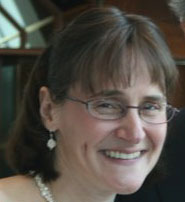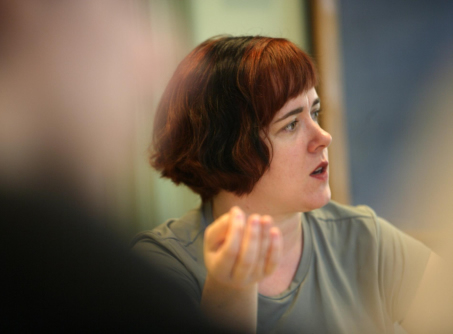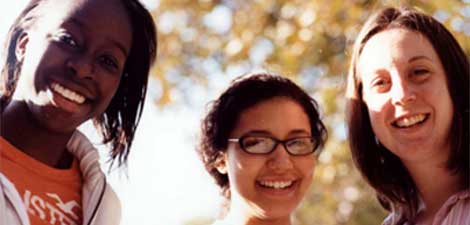Mara Miller, whose beat is the arts, writes about a new media installation at Haverford College.
Heather Taddonio, who is writing about science, reports on a new exhibition at Bryn Mawr about Charles Darwin.

Mara Miller, whose beat is the arts, writes about a new media installation at Haverford College.
Heather Taddonio, who is writing about science, reports on a new exhibition at Bryn Mawr about Charles Darwin.
A new exhibit offers a visual challenge
By Mara Miller
When you walk into the gallery, the first thing you notice is a loud grinding noise, like gears or heavy cogs. The room is dark, but a rotating projector flashes alternating images at four large screens. On one, a child’s birthday party, then more scenes from everyday life. On another, animated lines of text. Turn around, and you see what that sound is-no gears, but an image of a giant manual stamp, like they use at a library checkout, angrily punching out dates.
This sound and video installation, called Guarded, is the first in John Muse and Jeanne C. Finley’s three-part exhibition Imaginative Feats Literally Presented: Three Fables for Video Projection, which opened Friday at Haverford’s Cantor Fitzgerald Gallery. Muse, now an Associate Professor of Fine Arts,was Haverford’s Mellon Postdoctoral Fellow last year. Finley has collaborated with Muse since 1988.
The pieces have each been shown at festivals and galleries across the country since 2003, but this marks the first time they’ve been assembled together.
The new exhibition has already generated chatter around campus for its portrayal of the ways in which Americans participate in and deal with the war on terror and our presence in Iraq through picture, sound, and text. Haverford, with its politically engaged population and pacifist Quaker roots, proves a rich launching point for Muse and Finley’s work.
Stunning…and confusing
At the gallery’s opening, the room and surrounding halls overflowed with people eager to see what the much anticipated exhibit, advertised mysteriously with camouflage-themed posters, was all about. On the next day, about 30 curious viewers returned for a more intimate talk with the artists, moderated by Andrew Suggs, Executive Director of Philadelphia’s Vox Populi art gallery.
This was a valuable chance to make some sense of the stunning, but undoubtedly confusing, set of images and sounds on display.
The text from Guarded was culled from Red Cross pamphlets discussing what citizens should do in a disaster. Muse explained that one of the driving themes of the piece was political manipulation in times of vulnerability. “We look at how people’s ability to be caring can be exploited for political purposes,” he said.
He also pointed out the simple scenes being projected intermittently, like people going to work or getting married, and their relationship to the dates and words. He said, “It’s about the very idea that a calendar can make intelligible the things we’re sensitive to.” Continue reading
The scholars who were Darwin’s ancestors
By Heather Taddonio
It’s the age-old story of a true adventurer: a man enraptured by the world around him who disobeyed his father’s wishes when he accepted an offer to sail around the world pursuing his hobby in the name of science. His name was Charles Darwin.
Darwin is one of the most famed names in the sciences, but what about the evolution of the theory of evolution? Bryn Mawr College’s Special Collections Department’s exhibit titled Darwin’s Ancestors: Tracing the Origins of the “Origin of Species” profiles some of Darwin’s most influential but often unsung predecessors of natural history.
Housed in Canaday Library’s elegant Rare Book Room, the exhibition features artwork, books, and text incorporating specimens from notable – but unknown — scientists including Joannes Jonstronus, Thomas Burnett, John Gould, Erasmus Darwin, and Charles Lyell. These predecessors “laid the groundwork for our modern understanding of the nature of life on earth,” according to the exhibit.

Charles Darwin
The exhibit, which opened on Oct. 22 and will run through Feb. 2010, was opened with a lecture titled “Disagreements Among Friends: How T.H. Morgan and E. B. Wilson’s Agreeing to Disagree Helped Establish Genetics and the Modern Synthesis” by Swarthmore biology professor Scott Gilbert.
Lost in the science-speak? Gilbert’s lecture hits close to home: Wilson and Morgan were Bryn Mawr’s two first biology professors and were prominent players in the 20th century evolution debates.
Darwin’s ancestors
Darwin’s Ancestors is curated by Director of Library Collections Eric Pumroy, art history graduate student Angelique Wille, and undergraduate medieval studies major Marybeth Matlack. The exhibit coincides with the 200th anniversary of Darwin’s birth and the 150th anniversary of his celebrated book On the Origin of Species. Continue reading
The Haverford professor is on a mission of discovery
By Harper Hubbeling
Jennifer Punt wanted to grow up to be a writer.
“My dream in life was to be a novelist,” said Punt, leaning back in her chair to glance into the lab adjoining her office on the second story of the Koshland Integrated Natural Science Center at Haverford College.
Punt, 48, is no novelist. She is a biology professor and researcher at Haverford. Her lab studies immunology, looking at the development of thymocytes, a type of white blood cell critical to the body’s immune response.
Punt said she was, “very shy,” and, “very nerdy,” as a kid and that she was always, “very bad at following directions and learning a body of something that was already defined.”
“I just wasn’t that interested,” Punt said.
What did interest Punt?
“Since I was very little, I wanted to discover something,” Punt said. She recalls playing piano as a girl, slamming her hands down on the keys with the intense frustration of, “just wanting to discover something,” and not knowing how.
Punt was an undergraduate at Bryn Mawr College from 1979 to 1983. She went on to get a doctoral degree in veterinary medicine her the University of Pennsylvania. In 1996, just 13 years after leaving the Bi-co, she returned, beginning her teaching and research career at Haverford.
Her mission: discovery
At Haverford, Punt’s job description includes, “discovering something.”
“I couldn’t imagine a better job,” she said, “what more could I ask for than to be able to figure things out… I can be very excited by knowing that I know something new.”
And what is Punt is discovering? Continue reading
Professor Kate Thomas on food & literature
By Clare Mullaney
In Bryn Mawr College’s English department, novelist Mary Wollstonecraft Shelley isn’t just a great writer, but a vegetarian.
This is how Kate Thomas, an associate professor of English at Bryn Mawr, describes the 19th century author. She brought her interest in food studies to the college in 2005 with the creation of a class entitled “Eating Culture: Britain and Food 1789-1929,” which explores the role of food in English literature, specifically highlighting food’s effect on power, politics and trade.
Primarily a Victorianist and a critical and cultural theorist, Thomas found her interest in food studies later in her career after graduating from Cornell University Graduate School in 1996.
She later returned to Oxford University, where she had studied as an undergraduate, to get her doctorate in English Literature in 2003. 
Thomas had been doing reading about how food hadn’t received much attention in the academic world and decided to incorporate food into her study of literature.
Food studies is a relative new academic subject, said Thomas, but it encompasses many different disciplines, ranging anywhere from anthropology, to botany, to history, to English.
Nonetheless, food studies tend to focus more on the social sciences than on literature, something that Thomas hopes to change through her own studies and teaching.
Eating Culture
Thomas emphasizes the importance of academic study in assessing cultural issues such as food.
“If we don’t have scholarship, we’re missing a vital piece of how to culturally work together,” she said. Continue reading
The woman who helps make Haverford green
By Kulia Woodell
There is nothing that Claudia Kent likes better than to romp around outdoors and play in the dirt.
A woman who is clearly more comfortable assessing tree health and poking around in the perennial beds than sitting at a desk, Kent is Haverford College’s grounds manager and sustainability officer.
“I do a little bit of everything,” Kent says, laying down a long list of her daily duties. She is in charge of maintaining the athletic fields, mowing the grass, repairing washouts on the Nature Trail, and caring for the on-campus flora.
As the main player in the ‘greening’ of Haverford, she works with students to compost waste from the dining center for use in the student garden on campus.
“This year the garden gave us tomatoes, potatoes, beets, green peppers, and pounds of green beans,” Kent said. “Haverford is historically a farming school. We’ve kind of gotten away from that now, but I’m working on proposals for a big campus farm.”
She finds a new enthusiasm in talking about the Bur Oak next to Magill Library. “It’s 175 years old, and they can live to be 500,” she said. “I just love the trees. I think Haverford has amazing trees.”
Walking through the fall colors, or, as Kent specifies, the reds of the Sugar Maples and the golds of the Honey Locusts, she recalls growing up in rural England. “I was always outside building forts and playing in the fields and river,” Kent said. Continue reading
One Haverford student’s fight against the Apple iTunes oligarchy
By Mike Troup
The Recording Industry Association of America has been fighting a battle against online music piracy since the creation of illegal music download websites, starting with Napster in 1999. The RIAA has begun to enjoy success lately in catching people pirating music thanks to technology that allows monitoring services to search the database of music download programs and find people who are illegally sharing music.
Leave it to a Haverford College student to find a way around illegal file sharing — as well as a loophole in the music downloading system.
Introducing the hero: Joe Huttner. Huttner, 21, is a senior at Haverford. The New Jersey native is the creator of SadSteve.com, a music download website launched from his dorm room in January, 2008. He is determined to show that music can still be distributed over the internet without any hassle from the RIAA and major music labels.
“My inspiration for the site came in August, 2007, following a discussion with a friend regarding the current, weakened state of the music industry,” said Huttner, leaning back in his chair as if he was Marlon Brando in The Godfather.
Apple Inc.’s takeover and near monopolization of legal digital music distribution through iTunes is what made Huttner feel like he had to take action. While the 6’3″ baseball player turned internet wiz appears to be a gentle giant, he is hardly soft-spoken.
“The industry’s major problem, in our minds at least, was its newfound allegiance with Apple Computer, Inc.,” he said. ” Labels had relinquished control of the fastest growing distribution channel, the digital one, to Apple, a company devoted to technology, not music production.”
Huttner set out to create Sad Steve to connect with music fans directly. It has a library of songs available for download that is increasing in size every day.
“Sad Steve is first and foremost an audio search engine,” said Huttner. “The search engine finds music, podcasts, comedy tracks, and even speeches.”
The way that music is made available on Sad Steve is simple. The site indexes mp3 files (the file type of most audio files) that are available all over the internet. Users can then download the file directly from the site to their computers.
“For example,” said Huttner, “If the website for John’s California Surf Club hosts a Beach Boys song, that file is indexed and made available to you, the user.” Continue reading
Most Haverford students rarely leave campus. This like life inside the bubble too much to venture outside.
By Robert Breckinridge
Students at Haverford College often find they are lulled into a comfortable complacency that leads them to rarely venture out of the confines of campus. For decades, they’ve called this tendency the Haverbubble.
But, is the Haverbubble real or a myth? Is is only a legend passed down from one generation of students to another, or is it the real thing. Now it can be told: it is the real thing.
In an anonymous survey to students at Haverford, 58 % of the 509 respondents – a reply rate equal to 45 % of the student body — said the Haverbubble is real and they never escape it. Another 32 % said they rarely leave the campus.
The survey shows that most students spend most of them time at Haverford on campus, rarely venturing outside – even to nearby establishment, even more rarely to Philadelphia, which is just a 20-minute train ride away.
And, according to the survey, most of them like it that way.
Sophomore Steve Chehi said, “the Haverbubble is a great thing for about 25% of the student body 100% of their time here. And a great thing for the other 75% of the student body for their first two years they are here.”
Part of the attraction of Haverbubble is that it can be as insulating and comfortable as crawling under your covers on a cold night.
“To me the Haverbubble is an island, it keeps me safe, its where I learn,” said Kyle Norton, another sophomore.
It is easy to imagine Haverford being an isolated 19th century village. Continue reading
The McBride program at Bryn Mawr College gives women a chance to go to a school later in life.
By Juliana Reyes
Four women sit around a table and there’s a language barrier. Yvette Tucker, a black woman with short braids, manicured nails and silver butterfly earrings speaks broken French. Elisa Landaverde, a young, stylish girl from Mexico speaks Japanese. Georgette Hedberg, 63, speaks a little Polish. Marie Steeb, blond and pretty, speaks German and sounds like a native. They all concentrate when Tucker poses a question.
“Qu’est-ce que tu fais ce soir?” she says. Her French accent is getting there.
The women pause and look around. Then Hedberg breaks the silence.
“I think it sounds like, ‘You’re ugly.'” The women all burst out laughing.
Though they may seem completely different, these women are intimately connected. They are McBride scholars at Bryn Mawr College.
The McBride program, named after Katharine McBride, the fourth president of Bryn Mawr, began in 1985. It allows women who are beyond traditional college age to study at Bryn Mawr in order to receive their undergraduate degree. Though they range in age from 24 to 77, they are similar to the other Bryn Mawr students in many ways.
They are expected to fulfill the same requirements, they are eligible for financial aid and they have the opportunity to live on campus if they wish. One main difference is that McBrides do not have to attend Bryn Mawr full time. This is called “self-pace” and it allows them to choose how many classes they take each semester. Because of self-pace, McBrides sometimes stay for longer than the normal four years.
Rona Pietrzak, Associate Dean and Director of the McBride Scholars Program, says that some McBrides leave Bryn Mawr for a couple of years for different reasons, such as family problems, but they almost always come back.
The McBride application process is unique because as Pietrzak says, “We have their whole lives to look at.” Pietrzak explains that the application involves three letters of recommendation, four “fairly substantial” autobiographical essays and no SAT scores. McBride Scholar Joanne Bunch calls the application process “the most daunting thing about being a McBride.” She says she was going to apply to Smith College as well, but when she saw that Smith required one essay as opposed to Bryn Mawr’s four, she thought, “You can fake one essay, but you can’t fake four.” She thought of it as Bryn Mawr’s way of weeding out the weaker candidates. Continue reading
Note: The names in this story were changed at the request of the sources in exchange for their candor on this topic.
By Michele Khilji
Sarah Aziz and Imran Khalid’s first anniversary is quickly approaching — not their wedding anniversary, but one year since they started dating.
Imran attends Rice University in Texas, but flew to Philadelphia to spend time with Sarah while they worked on their exams together. While Imran sits alone in Canaday Library, at Bryn Mawr College, Sarah sneaks away to the library stacks to work on Imran’s anniversary gift.
Being secretive is not new to this couple; this anniversary also marks a year of keeping the relationship a secret from their parents.
Sarah and Imran are just some of many children of South Asian immigrants who find themselves stuck between the American and South Asian ideals of love and marriage.
Marriage in South Asia is viewed as a binding relationship between the two families of the wedded, and traditional arranged marriages have been part of the culture for thousands of years. In an arranged marriage, the parents choose whom their child will marry. In South Asian culture, it is believed that an arranged marriage preserves cultural and class traditions, as well as serves as a “knot” that ties two families together.
Sarah and Imran both are children of Bengali immigrants. They share the same background and fit their parents’ criteria for potential spouses. So why do they hide that their relationship?
Imran’s parents are against dating because they view it as a possible distraction from studies. Imran’s father wants him to focus on studies and believes that his son is not in a position to take on a relationship. Although Sarah’s parents are not opposed to her dating, they would rather “save her reputation” by formalizing the relationship as an engagement. Sarah and Imran know they want to marry each other but have agreed that after Imran completes medical school they will reveal their relationship to their parents. “We have a two-year plan”, chuckled Imran.
When children of immigrants do not submit to their parents’ authority, they are described as being “too American”. So while individuals like Sarah and Imran end up choosing potential partners who are the same ethnic background, the way they made their choices and the timing still depart from traditional arranged marriage.
To find out more about views on arranged marriage, a recent survey of South Asians, most of them students at Bryn Mawr and Haverford, polled them on their views on dating and marriage. The survey was distributed via the email list serves of South Asian affinity groups, such as Bryn Mawr College’s South Asian Women (SAW) and Haverford College’s South Asian Students (SAS). In addition, an open Facebook event was created encouraging South Asian students to participate. Sixty seven responses were received, 59 of them women and 8 of them men. Their responses were anonymous, but respondents were able to leave comments. Continue reading